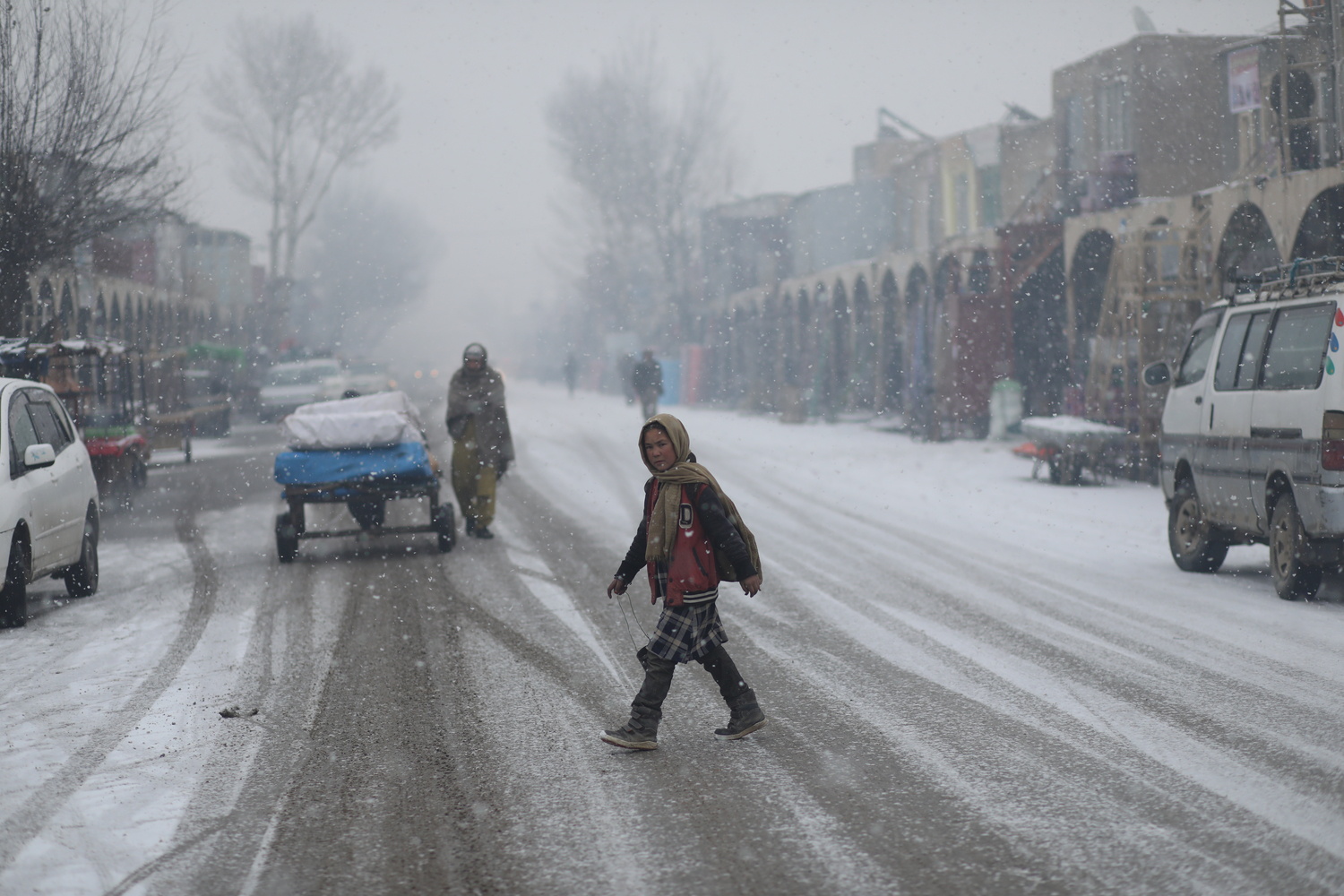Humanitarian Catastrophe in Afghanistan: A Crisis by Choice
One of the world’s most serious humanitarian crises is taking place in Afghanistan and it is largely the result of flawed assumptions of Western policy following the Taliban’s seizure of power. The West’s suspension of development aid has led to the collapse of the economy and to hunger for millions of Afghans. Instead of forcing the Taliban to respect human rights, the actions will have the opposite effect—a humanitarian catastrophe, mass migration, and a failed state. The European Union may soon face these effects directly, so it should take steps to resume development cooperation and avert the worst-case scenario.
 Fot. Reuters/ ALI KHARA / FORUM
Fot. Reuters/ ALI KHARA / FORUM
The Humanitarian Situation
According to the United Nations, 97% of Afghanistan’s population will be living below the poverty line in 2022 and more than half (24.4 million people) are at risk of hunger and in urgent need of help. In addition to the Taliban takeover of power, the situation in the country deteriorated last year because of the intensification of warfare, droughts, and the impact of the COVID-19 pandemic. On 11 January, the UN issued an appeal for $4.4 billion in humanitarian aid (beyond long-term development aid) to Afghanistan for 2022, the largest ever request for a single state. This is a huge increase compared to 2021 when humanitarian needs were estimated at $860 million. By 13 September 2021, after the Taliban had seized Kabul, donors promised an additional $600 million, and by the end of 2021 they had donated a total of $1.8 billion.
The humanitarian needs are increasing despite the country’s security situation improving after the Taliban victory and the end of most armed conflict. According to the UN, 1,050 civilian casualties have been recorded since 15 August 2021, including 350 killed, which is the lowest level in a comparable period in recent years (e.g., in Q4 2020 these figures were 1,901 and 891, respectively). Nevertheless, instead of garnering a peace dividend, the country began to plunge into even greater crisis. If immediate action is not taken by the international community, the UN warns Afghanistan may need up to $10 billion in aid in 2023.
The international community has demanded the Taliban enable access to humanitarian aid for the population, expressed, among others, in UNSC Resolution 2593 of 30 August 2021. The UN Security Council (UNSC) also agreed in December to ease sanctions to allow more humanitarian aid to flow to Afghanistan. So far, the largest donors of such aid have been the EU and the U.S. The European Commission announced in October last year that it would increase humanitarian aid to Afghanistan and the region to €1 billion. Both the U.S. and the EU have declared they would respond to the UN appeal, but a serious challenge will include providing aid at scale.
Causes of the Crisis
The Taliban are responsible for the economic situation in the country but they are not solely responsible for the humanitarian crisis. The limited potential of their own members and the removal of many people installed by the previous government has made it difficult to effectively run the state. The formation of an all-Taliban government unrepresentative of Afghanistan’s diverse society has weakened its legitimacy in the eyes of citizens and foreign partners. The limits on women’s rights and persecution of members of the previous system have complicated the perspective of normalisation. Although Taliban policies make it difficult to rebuild the country, the foreign partners who built up the Afghan state since 2001 also bear responsibility for the deteriorating economic situation.
Between 2001 and 2021, Afghanistan was one of the countries the most dependent on foreign aid in the world. Nearly 80% of public expenditures came from external sources managed by over a dozen trust funds. At the 2020 donors conference, it was agreed that $3.3 billion will be allocated annually to civilian development aid for Afghanistan by 2024. The U.S. paid out even more ($4.5 billion in 2018) to maintain Afghan security forces. In 2019, World Bank experts estimated that in order to maintain the functioning of the state, total foreign aid to Afghanistan could be gradually reduced from $8.6 billion in 2018 to $5 billion in 2024.
However, after the Taliban victory, all development and military aid was halted overnight. For several years, donors had been announcing that the continuation of support would depend on an inclusive political agreement and respect for the democratic achievements of recent years. Even during the Taliban offensive, Western governments warned the Taliban against taking power by force. However, given the events that transpired, the cessation of aid has left hundreds of thousands of officials, teachers, doctors, and other public sector employees without salaries, and the state has lost the resources to pay for public services or continue investments. This has left millions of people destitute. In addition, Afghanistan’s foreign exchange reserves (estimated at $9.5 billion) kept in U.S. banks were frozen and the state was cut off from the SWIFT interbank settlement system. As a result, cash liquidity froze and the economy fell by 40% of GDP.
Cutting off the Emirate from foreign aid is intended to be an instrument of pressure on the Taliban to respect human rights. It also results from the pressure of public opinion in the West, which is reluctant to finance a state ruled by this organisation amid fears that the funds would not go to ordinary Afghans anyway. However, the sanctions policy being implemented goes against the calls by the UN, aid organisations, and experts that point to the need to resume systemic civilian aid.
Perspectives
Economic pressure generally is unlikely to force the Taliban to fundamentally change their core values or domestic policies. They may announce minor adjustments to women’s rights or the inclusion of new people in the government, but they will not depart from their system based on an interpretation of Sharia law. For the Taliban to yield to Western pressure is to challenge their legitimacy—complying with Western demands would mean subservience like the democratic governments in Kabul that they had fought for more than 20 years and would result in a loss of support of members and followers.
The shortages of funds caused by the withholding of foreign aid will be compensated by the Taliban from other, probably illegal sources, including drug trafficking, cooperation with other extremist organisations, or extortion of the richer part of Afghan society. While these funds will sustain individual members of the Taliban, it will doom most of the population to poverty and dependence on what humanitarian aid may come.
In the longer term, the prolonged economic pressure will lead to increased social discontent and a weakening of the legitimacy of the Taliban rule. Together with government repression, this will likely increase tensions and strengthen the anti-Taliban opposition. It could lead to a fall of the Taliban government, but only after another bloody civil war, leading to the disintegration of the state.
Conclusions
Afghanistan is facing a peculiar situation in which life-saving humanitarian assistance is urgently needed to address the crisis caused by the halting of long-term development aid after the Taliban took power. However, considering aid a political tool of leverage may lead to the opposite of what is intended. Instead of forcing the regime to respect human rights, it will only deepen the socio-economic crisis and increase the suffering of Afghans while destabilising the country. This means Afghanistan’s dependence on humanitarian aid will deepen and the funds will only treat the symptoms and not the causes of the problem. This condition in the long term does not offer the prospect of Afghanistan’s sustainable development. It also increases the cost of aid to the international community.
The deteriorating economic and political situation will force more Afghan citizens to flee abroad, both to neighbouring countries and farther, to Europe and other safe places. It also increases the risk that Afghanistan will become not only a source of a severe migration crisis but also a centre of global terrorism and drug production.
These negative effects of such a scenario, particularly in the form of an influx of refugees, drugs, or terrorist attacks, will be felt sooner in Europe than, for example, in the U.S. Therefore, it is in the EU’s interest to change the world’s approach to the role of development aid in the strategy towards Afghanistan, especially since there are no other viable options of regime change after the withdrawal of foreign troops. However, this requires engagement with the Taliban and establishing the conditions for the resumption of development cooperation that would enable the state to function normally. The EU-Taliban meeting this January in Oslo was a good step in that direction. Both sides should establish control and monitoring mechanisms to ensure that aid reaches Afghan citizens and the economy, for example, through direct payments. If this proves effective, the EU should persuade the U.S. to gradually unfreeze Afghanistan’s assets. It also will be important to involve Afghanistan’s neighbours and regional powers China, Russia, and India. The reinstatement of aid does not imply international recognition of the Taliban. Such recognition should remain the primary tool to induce them to respect fundamental human rights.



